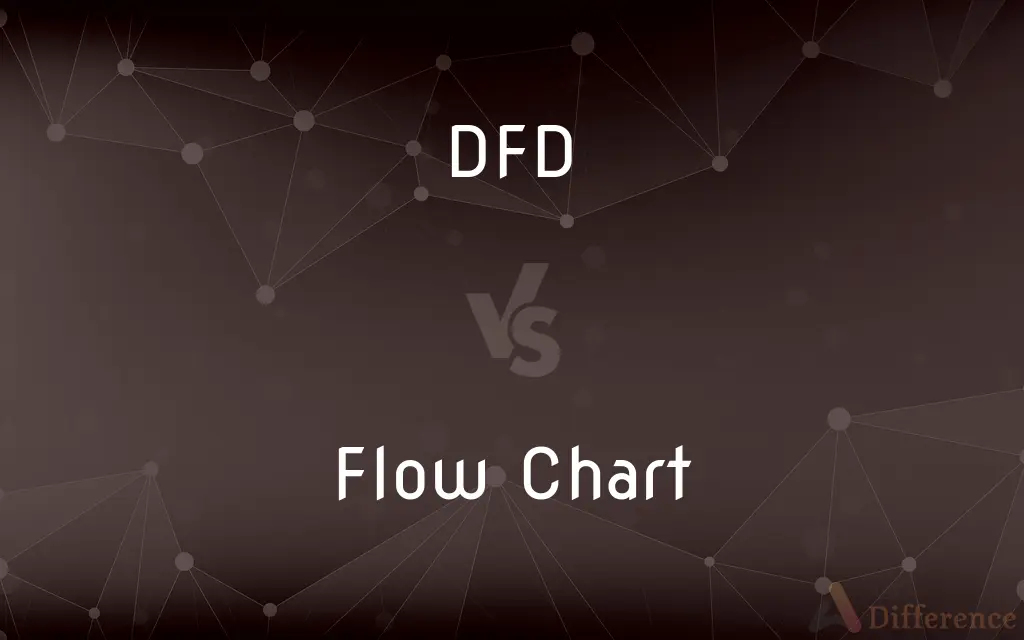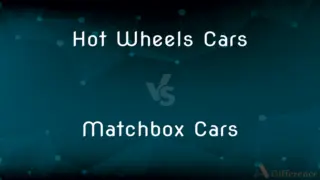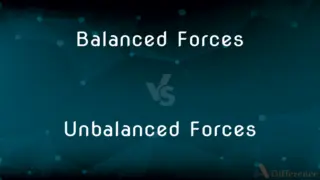DFD vs. Flow Chart — What's the Difference?
Edited by Tayyaba Rehman — By Fiza Rafique — Published on December 25, 2023
DFD (Data Flow Diagram) represents data flow within a system, while a Flow Chart depicts the sequence of steps in a process.

Difference Between DFD and Flow Chart
Table of Contents
ADVERTISEMENT
Key Differences
DFD, or Data Flow Diagram, is a visual representation primarily used in system design to illustrate the flow of information within a system. On the other hand, a Flow Chart is a diagrammatic representation that showcases a sequence of actions or steps taken in any process or activity.
While DFD focuses on data and how it travels between different entities or processes, a Flow Chart is more about the steps, decisions, and the order of operations. The symbols used in DFD are specific to the flow of data, like entities, processes, and data stores. In contrast, Flow Charts utilize a wider range of symbols like ovals for start/end, diamonds for decisions, and rectangles for processes or tasks.
DFD diagrams are essential in system or software development, helping developers and stakeholders understand how data is processed and where it's stored. Flow Charts, being more versatile, can be used in multiple domains, not limited to software, such as business processes, manufacturing processes, or any sequence-based activity.
The granularity of a DFD can vary, with levels ranging from a high-level overview to detailed data interaction. Flow Charts, however, typically provide a step-by-step visualization, ensuring clarity in sequential processes.
Both DFD and Flow Charts are critical tools in their respective domains. They aid in clarifying, visualizing, and optimizing processes or data flows, ensuring efficient and effective operations.
ADVERTISEMENT
Comparison Chart
Primary Purpose
Represents data flow within a system
Depicts the sequence of steps in a process
Focus
Data flow and storage
Steps, decisions, and order of operations
Common Usage
System or software design
Any process, including business, manufacturing, and programming
Symbols
Entities, processes, data stores
Ovals (start/end), diamonds (decisions), rectangles (processes/tasks)
Granularity
Can vary from high-level to detailed data interaction
Provides a step-by-step visualization of a process
Compare with Definitions
DFD
Emphasizes data processing and storage.
Using a DFD, we identified redundant data storage points.
Flow Chart
Has varied symbols for different process elements.
In the Flow Chart, diamonds represent decision points.
DFD
A visual representation of data flow.
The DFD helped us visualize the information flow in our software.
Flow Chart
Versatile across multiple domains.
Both our HR and tech departments use Flow Charts regularly.
DFD
A tool used in system design.
For our next project, we'll start with a DFD to understand data interactions.
Flow Chart
A diagram showing process steps.
The Flow Chart simplified our onboarding process.
DFD
Utilizes specific symbols for data interactions.
Ensure you use the correct symbols when drafting the DFD.
Flow Chart
Illustrates decisions, tasks, and sequence.
The Flow Chart highlighted where we need to make critical decisions.
DFD
Can range from high-level to detailed views.
Let's begin with a high-level DFD before diving deeper.
Flow Chart
Used to represent sequence-based activities.
I created a Flow Chart to detail the manufacturing steps.
Common Curiosities
Do DFDs and Flow Charts use the same symbols?
No, DFDs have specific symbols for entities, processes, and data stores, while Flow Charts use symbols like rectangles and diamonds.
Are Flow Charts only for technical processes?
No, Flow Charts are versatile and can represent any sequence-based activity, technical or not.
What's the primary use of a DFD?
DFDs are primarily used in system and software design to understand and represent data flow.
Is a Flow Chart the same as a DFD?
No, while both are diagrams, a Flow Chart represents process steps, while DFD illustrates data flow in a system.
Where can Flow Charts be applied?
Flow Charts are versatile and can be used in business, programming, manufacturing, and other process-driven domains.
Can DFDs represent decision points like Flow Charts?
While DFDs primarily focus on data flow, decisions related to data processing can be represented, but not as explicitly as in Flow Charts.
Which tool should I use for software development?
Both can be useful. DFDs are great for understanding data interactions, while Flow Charts can represent the software process.
Which is more detailed, DFD or Flow Chart?
Both can be detailed, but DFDs can range from high-level overviews to intricate data interactions, while Flow Charts focus on process steps.
What does DFD stand for?
DFD stands for Data Flow Diagram.
How do I choose between DFD and Flow Chart?
Choose based on your goal. If you're focusing on data flow, use DFD. If you're detailing a process or sequence, use a Flow Chart.
Are there software tools for creating DFDs and Flow Charts?
Yes, many software tools exist for both, such as Lucidchart, Visio, and Draw.io.
Do Flow Charts always have a start and end point?
Typically, yes. Flow Charts often use ovals to denote start and end points.
How do DFDs handle external entities?
In DFDs, external entities, which interact with the system but are not part of it, are often represented using ovals.
Can a Flow Chart represent loops?
Yes, loops can be represented in Flow Charts using arrows that circle back to an earlier step.
How does a DFD represent data storage?
DFDs use a specific symbol, often a rectangle or two parallel lines, to represent data stores.
Share Your Discovery

Previous Comparison
Hot Wheels Cars vs. Matchbox Cars
Next Comparison
Balanced Forces vs. Unbalanced ForcesAuthor Spotlight
Written by
Fiza RafiqueFiza Rafique is a skilled content writer at AskDifference.com, where she meticulously refines and enhances written pieces. Drawing from her vast editorial expertise, Fiza ensures clarity, accuracy, and precision in every article. Passionate about language, she continually seeks to elevate the quality of content for readers worldwide.
Edited by
Tayyaba RehmanTayyaba Rehman is a distinguished writer, currently serving as a primary contributor to askdifference.com. As a researcher in semantics and etymology, Tayyaba's passion for the complexity of languages and their distinctions has found a perfect home on the platform. Tayyaba delves into the intricacies of language, distinguishing between commonly confused words and phrases, thereby providing clarity for readers worldwide.











































